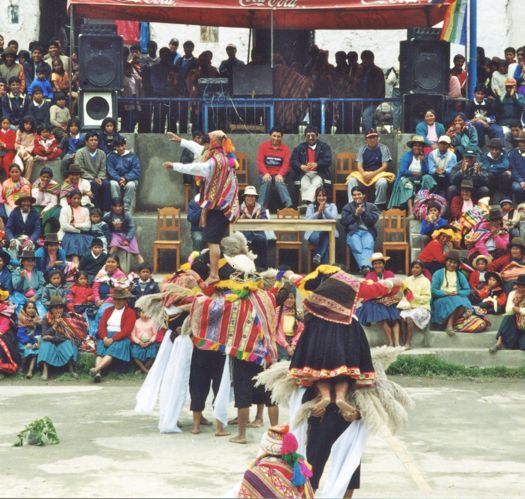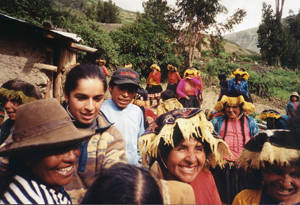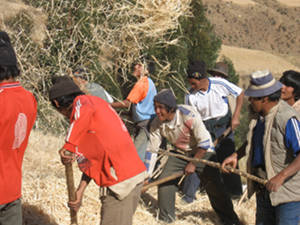In this post we continue to pursue an understanding of how the complementarity of opposites informs the Andean people’s understanding of themselves, their relationships with each other, and their relationships with the Cosmos. In earlier posts we looked at the basic concepts underlying the complementarity of opposites (Yin/Yang of the Andes), how it informs the relationships between women and men (Wharmi-Qhari), and how the ritual encounter (‘tinkuy’) of differing energies can give rise to new life force (Tinkuy: Confirming the Rules of Life).
In that latter post tinkuy was introduced within the context of ritual battles that up until recent times were waged between neighboring communities in the Andes, and in the whipping dances that continue through today. In this post I would like to take a look at tinkuy in the form of competition between communities and between individuals, and then use that as a foundation to understand don Americo Yabar’s description of the three levels of relationship between people in the Andes.
The true treasure of the Andean Cosmovision is found in the ways that it differs from the view of reality offered by my modern, western, culture. This difference is deeper than simply having a different set of beliefs, or a different set of meditative practices, and this is exactly what is lost if we skim off a few beliefs and meditations from the Andean culture and toss them into our eclectic bag of ways for working with the energy of Nature. The change I believe we need as a culture if we wish to head toward a future of greater beauty and health, not only for us but for the whole planet (our future cannot be beautiful or healthy without accomplishing that for all of Nature as well) involves deep and fundamental changes in the way we experience reality, and in our relationships with each other, in our relationships with the Cosmos, and with the various aspects of our own Being.
The Festival of Qoyllu Rit’i
We have seen the role of tinkuy in the ritual battles and whipping dances of the festival of Pukllay (earlier post), now I’d like to turn to the expression of tinkuy in the dance and band competitions found in the Andean festival of Qoyllu Rit’i (held in May/June of each year). Qoyllu Rit’i is a time when communities of the region come together on the slopes of the majestic Apu Ausangate range. Communities bring their own bands and dance groups to compete during the festival. The battle of the bands is somewhat like a real battle in that the various bands don’t just take turns playing their best but at times try to drown each other out with their music. The competing dance groups have worked long and hard during the preceding year on their costumes and on their dances in the hope of outperforming both in style and energy the other groups. These band and dance competitions are tinkuy, an encounter of differences leading to a union that is greater than the sum of its parts.
“It may seem paradoxical that competition enters so strongly into an event that serves to integrate ayllus (communities defined by relationships) over a large region, and whose overall effect is to produce an overwhelming sense of ‘comunitas,’ an ecstatic submersion of individual selfhood into a larger whole. Yet it is exactly the competition–the clash of ayllu with ayllu, province with province, puna (high grasslands) people with valley people–that explodes in a huge jingle of sound and blaze of color, in an intensity of activity and noise, which vibrates for a few days in the sun and ice of the Apu’s glacial solitude.” (Allan, pg 176).
Paucartambo
My own experience of a regional dance competition was at a festival in the town of Paucartambo, which don Americo Yabar had taken me to see. It was a festival that is not well-known by outsiders and I was about the only non-Andean there (it was one of those ‘pinch me I must be dreaming’ moments). Some of the dance groups had walked over 15 miles through the mountains to represent their village in the competition. The photos below are of the dancers from the village of Mollamarka.
The Day of the Horse
Dance and band competitions are tinkuy between communities. Competitions in the Andes can also be between individuals. In her book Rituals of Respect the anthropologist Inge Bolin describes a horse race that plays the title role in a sacred festival held in the high Andes, a festival the locals call ‘The Day of the Horse’.
The festival is held to honor (in ayni for) ‘Illapa’, the Andean deity of thunder and lightning. As a reminder (from earlier posts), the Quechua language has no word that translates without distortion into our word ‘god’. The Andean gods are not transcendent spirits, they are, instead, the consciousness inherent in that aspect of Nature or the Cosmos.
The honoring of Illapa plays an increasingly important role in the culture as one moves higher up in the Andes. In the high villages death of both people and their animals by lightning is a recurring threat. The thundering sound of the horse’s hooves during the race and the celebrations surrounding the event honor and appease Illapa.
The race is held in a high mountain valley with the massive range of Ausangate towering over its far end. The track is about two kilometers long, at its end the riders need to negotiate a steep mountain side before returning. Women, children, and men not in the race sit on the surrounding slopes to get a vantage point from which they can cheer and applaud the riders. The race is held in heats of four which take all day to complete. By the time the last, championship, heat is held it is dusk, and the riders disappear into the gloom of night to emerge again from the darkness as they come charging back.
Inge Bolin notes that the riders, who are called the ‘Sons of the Thunder’ are enthusiastic and every contestant hopes to win. And yet, while they are racing, they often sacrifice speed to sit up and swing their warak’a (slings) above their heads and jubilantly shout out the names of important sacred sites and spirits. ‘Every contestant hopes to win. Yet, it is more important to participate, to celebrate this day, to remember the gods, to be together in joy and harmony.” (Bolin, pg 173).
In the evening, when the race was over, Inge realized that she hadn’t heard who had won. She asked the people around her but they just smiled. Finally, someone pointed out the winner. “I congratulate him for having won this thrilling race. He smiles and shyly averts his eyes. Only later do I full comprehend that winning is not the prime reason for staging the race, and I realize that it was not proper behavior to ask for the winner or to congratulate him openly. In an egalitarian society where respect for others is a primary concern, it is not considered polite to make much fuss about one person, stressing his individual achievement to the detriment of others. The race was a success…The gods were pleased…It was a great competition in which the riders competed with and not against each other. Everyone who witnessed or participated in this energetic ritual was equally important.” (Bolin, pp 173-174).
As I read the phrase ‘competed with and not against each other’ something arose in my mind, something I remember don Americo Yabar talking about years ago that had not made sense to me at the time. Now I think I have a better understanding of it.
The Three Stages of Relationship
Americo was describing three stages that can occur in a relationship. The first stage of a relationship he called ‘tinkuy’, and he uses the term a bit more narrowly than Bolin and Allen. Tinkuy is the encounter of two different energies (e.g. two different people). This happens when the sphere of energy around one person first comes into contact with the sphere of energy around another. At this point one can begin to sense in which ways you are similar and in which ways you differ from the other person.
The second stage in the relationship Americo calls ‘tupay’, which he described as involving a competition between the two people. At this point in the explanation, in my notes, Americo hesitates and tries to explain the nature of this competition, that it is not the western, aggressive form of competition where a victor stands in triumph over the loser. I could never quite grasp what he was getting at until I read Bolin’s account of ‘The Day of the Horse’, a jubilant race where you compete with the others rather than against them. The point of the competition in ‘tupay’ is not to triumph over your competitor, but to discover in which areas each of you excels over the other.
For the relationship to then reach its deepest level, the third and final stage is to move from ‘tupay’ into ‘taqe’. In ‘taqe’–now that you have found what each one of you is better at–you bring the other person up to your level of expertise in that area. You become equal by both of you becoming more than you were before.
These three stages are described by Joan Wilcox (from her studies with Americo and others) in the book Masters of the Living Energy: The Mystical World of the Q’ero of Peru (pp 58-62). She goes on to explain how this process informs the living tradition of the Andean Cosmovision. The people in the Andes who are the maestros of the Andean Cosmovision are called paqos (also spelled paq’o). They differ in their ability levels, in what they can accomplish in dancing with the living energy of the Cosmos. Their abilities are not, however, measured by their adherence to a set of specific, traditional, teachings or techniques. The abilities are, instead, the product of their relationships with other paqos, who all have their own set of knowledge and skills. And through the process of tinkuy, tupay, and then taqe these skills are shared with others. As you grow in skill from these relationships you are more able to learn higher skills from others, and you will be more in a position of being able to share something they would benefit knowing how to to do as well.
I would like to expand our view a bit and look at all of the parties involved in these relationships. The abilities of the paqos concern their relationships with the vast, beautiful, sometimes frightening, mysterious, unfathomable multitude of beings (consciousnesses) of Nature and the Cosmos. The ability of interacting, for example, with an Apu (a being who is a majestic mountain peak) is not just a skill, it is a relationship between two beings, the Apu and the paqo. Learning from another paqo how to open the door to that relationship is one step, what happens after that is up to the paqo and the Apu. The skills of the paqos, thus, are not just based upon what the paqos have learned to do, they are also the result of their subsequent relationship with Nature and the Cosmos.
Summary
In looking over the past few posts this is what I see. There are at least three patterns of healthy relationships in the Andes.
1) When two differing energies/beings (complementary opposites) come together they can retain and honor their differences, yet form a union, and this is called ‘yanantin’, the harmonious bringing together of complementary opposites, which leads to a whole that is greater than the sum of the parts. From this union of complementary opposites new life force emerges from the synergy of the complementary energies dancing together. A harmonious interaction of female and male energies is an example of yanantin.
2) When two similar energies/beings come together this is called ‘masintin’. I do not know if the alliance of two similar energies also produces a whole that is greater than the sum of the parts, or if it creates a whole that is equal to the sum of the parts. I suspect it is the latter but none the less beautiful for that. In our lives we have the opportunity to form many yanantin and many masintin relationships.
3) A third option is one that might be called co-evolution, where we start off by noting our differences, specifically differences in our abilities, and then we endeavor to pull each other up to our best levels. What starts off as difference ends up as equality, not by finding a mean but by mutual elevation. This, as I see it, is the path of the paqos.
Share...






